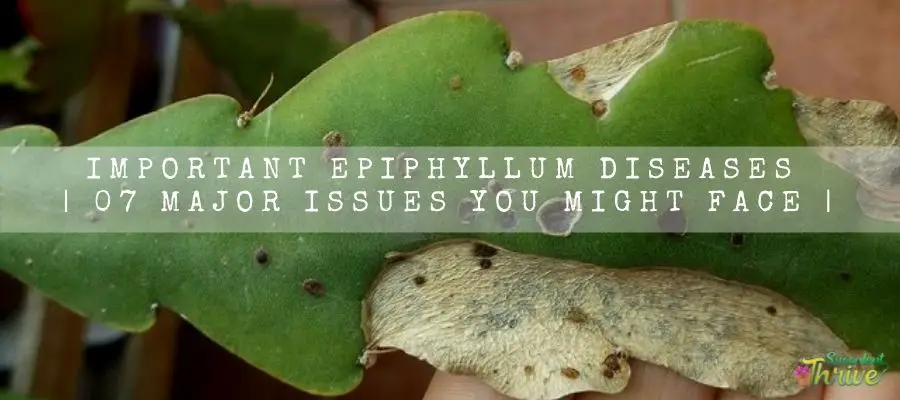Epiphyllum belong to the family cactaceae, and they have about 19 different species of epiphytic plants. These are native plants in central America. Epiphyllum go by the common names leaf cacti and orchid cacti. However, you may come across certain diseases when growing them and this article is about Epiphyllum diseases, which may come across during their growth.

01. Epiphyllum fungus
They can suffer from Epiphyllum fungus especially when you splash water at the plants.
Further high humidity levels around the plants and water remaining on the leaf surfaces for six hours could also contribute to this condition.
If your Epiphyllum is suffering from this condition, you could spot them forming lesions. Those lesions would form in different forms.
Besides, chances are that you could spot them containing pustules which resemble pinpoints.
To prevent them occurring, ensure that you always keep their soil mix dry. Fungal diseases wish to have a moist environment.
Grow them in a soil mix which has excellent draining so that there will be no excess moisture retained in the pot. Soil is the key factor which helps to spread diseases.
Orchid cactus are epiphytes which literally means they can thrive without soil.
Thus, you may grow them in a medium container which has a smaller amount of soil and which has a greater component of peat moss and perlite. Moreover, ensure that you are using all sterile tools pots and planting ingredients too.
Further when watering, make sure that you allow the soil to wither and then proceed with watering.
You need to water the plants away from the plant base so that it will create less probability in creating stem rot as well as root rot.
Usually, Epiphyllum’s root system does not form deeper. Hence when you overcrowd the plants in the pots, it would contribute to poor air flows which would eventually result in fungus growth.
Therefore, I suggest you divide the plants after some years and transplant them into slightly bigger pots which will enhance the air circulation around the plants.
02. Scale on Epiphyllum
You could spot scales especially on the night blooming Epiphyllum plants.
They would usually damage the plants by sucking the plant juice which could ultimately cause the plant to weaken and to have wrinkled and shriveled leaves.
If their infection spreads on a severe level, chances are that it could even be fatal on the plants. To treat them, you can mix some rubbing alcohol and a few drops of dishwashing liquid and then apply it on the damaged plant parts.
03. Black spots on my epiphyllum
Black spots are a disease which is occasionally spotted among the Epiphyllum plants and sometimes it could create severe repercussions.
A bacterial infection or a fungal infection could be the root cause for black spots on the epiphyllum.
They make the Epiphyllum decay and cause discoloration of the foliage as well. Epiphyllum are quite attractive for several bacterial and fungal pathogens which could create black rot. To treat them, you may use a fungicide and apply as per the labeled instructions.
04. Epiphyllum turning red
Excessive sunlight is the root cause for Epiphyllum turning red. Besides, excessive sunlight and inadequate water could also cause the plants to turn red.
In addition to that , nutrient deficiency could also be a reason to turn the plants red. On the other hand, insufficient sunlight levels could also turn the Epiphyllum plants red.
Once you identify the root cause for the Epiphyllum turning red, you need to act accordingly and try to provide the best care treatments.
05. Epiphyllum wrinkled leaves
Epiphyllum could produce wrinkled leaves if they lack sufficient water levels. Balancing the water level is quite critical when looking after these plants.
To treat them, you can place your plant in a sink or in a tub. Do not leave the saucer with the plants. Next fill the basin up with water for about 3-4 inches depth of water. Ensure the water you are using is at room temperature.
Next, soak the plants with water for about 45 minutes. Next ensure that the top layer of the soil is moist after you soaked the plants.
In case the soil is not saturated, you should water the soil from the top so that it will saturate the soil faster. When you spot the plants,soil is moist , you could let the excess moisture drain from the draining holes.
06. Epiphyllum mosaic disease
The viral mosaic of Epiphyllum is the worst disease that Epiphyllum may suffer from. It could be deadly plant disease.
When Epiphyllum suffer from viral mosaic disease, they could form light colored spots and faded edges of the stem as well.
Moreover, their buds may also start to fall off from the plants. To rescue the viral mosaic infected Epiphyllum, you could remove the damaged areas first.
Next, you may treat the healthy ones with fitosporing too. Finally quarantining them would also be handy here.
07. Epiphyllum rust
Epiphyllum rust literally means forming small red and black spots on the Epiphyllum foliage.
There are some factors which could contribute to this condition such as waterlogged soil, sunburns, accumulation of water droplets on the stems etc.
To remedy them you can treat them with fundazol and adjust the way you look after the plants too.
How to prevent Epiphyllum diseases
To prevent these conditions of the Epiphyllum plants, you need to water them moderately whilst using warm water.
Ensure that you do not apply tap water for watering. If you end up using tap water, the minerals such as chlorine could create yellow spots in the shoots.
Further if you make the Epiphyllum soil waterlogged, it will make the Epiphyllum stems discolor. Eventually it would result in the rot as well.
Further when the plants are lacking water, it would make the plants shoots shriveled and wither.
Consider feeding them with the recommended quantities. If you end up over feeding them, it will deteriorate the plants health as well as the Epiphyllum blooms as well.
Failing to feed them properly will crack the shoots as well. You can further be tactful in shifting the cactus outdoors during warmer times. Never expose them to the cold though.
In addition to that, you can apply the chemical treatments also to safeguard the plants from the pests and from the viruses.
You need to expose the Epiphyllum plants for moderate sunlight , but not for direct sunlight though. as, it will cause the plants to wilt and to turn yellow too.
On the other hand, the lack of sunlight will badly impact on the plant’s bud formation and for flower blossoming as well.
In addition to aforesaid guidelines, you need to select a soil type which is suitable to grow the Epiphyllum plants.
Ideally it has to be a soil mix which is enriched with nutrients. Further ensure you do not damage the plants during the transplanting. Further consider pruning the plants as it would help to form new growths of the plants.
Conclusion
To wind up, Epiphyllum are such spectacular plants which anybody would want to have. However, if you look after these plants well, you can avoid these diseases which would result in a healthy growth in the plants.
Read Next : What Is Eating My Succulents At Night? | 14 Reliable Facts | Euphorbia Problems | 15 Major Problems They Encounter | 7 Fungal Infection On Succulents? | How To Treat Them |


